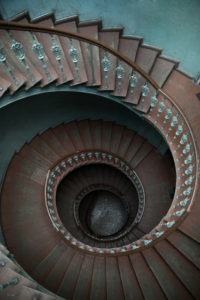
Antipsychotic or neuroleptic drugs became big business for pharmaceutical companies about nine years ago, reaching sales of $14.6 billion in 2008. This made them the best selling therapeutic class of medications in the U.S. that year. Not only are they used to treat psychosis and bipolar disorder, several have been approved as an add-on medication to treat depression. Additionally they are used off-label with children and the elderly for behavioral control. And they are the primary cause for a serious neurological disorder called tardive dyskinesia.
Tardive dyskinesia (TD) is a group of involuntary movement disorders caused by drug-induced (iatrogenic) neurological damage, primarily from antipsychotic drugs and a few others that block the function of dopamine in the brain. “TD can vary from a disfiguring grimace to a totally disabling array of spasms and often bizarre movements of any part of the body.” If TD is not identified early on and the drugs stopped, “these disorders nearly always become permanent.” Both patients and their doctors often fail to recognize or diagnose its symptoms.
The above short introduction was gleaned from Dr. Peter Breggin’s “Antipsychotic Drugs and Tardive Dyskinesia (TD) Resources Center.” If you can spare a few minutes, watch a ten-minute TD video edited by Dr. Breggin from existing videos available on the Internet. The video contains a series of individuals with the three general types of tardive dyskinesia whose ages range from pre-adolescence to seniors. These types are: tardive dystonia, a series of involuntary movements that include painful muscle contractions or spasms; tardive akathisia, psychomotor agitation; and classic tardive dyskinesia, the rapid, jerky movements or uncontrollable head bobbing or movements of the arms, hands, feet fingers or toes. The following is a reproduction of a table from Psychiatric Drug Withdrawal by Peter Breggin more fully describing the symptoms of tardive dyskinesia.
|
Symptoms of Tardive Dyskinesia |
|
Tardive Dyskinesia (Classic) |
|
Rapid, irregular (choreiform), or slow and serpentine (athetoid) movements; often bizarre looking; involving any voluntary muscle, including: Face, eyelids and eye muscles, jaw (chewing movements, tongue biting), mouth lips, or tongue (protruding, trembling curling, cupping) Head (nodding), neck (twisting, turning), shoulders (shrugging), back, torso (rocking movements), or abdomen Arms and legs (may move slowly or jerk out of control) Ankles, feet and toes; wrists, hands, and fingers (sometimes producing flexion, extension or rotation) Breathing (diaphragm and ribs; grunting), swallowing (choking), and speaking (dysphonis) Balance, posture, and gait (sometimes worse when slow, often spastic) |
|
Tardive Dystonia |
|
Often painful sustained contractions (spasms) of any voluntary muscle group; potentially causing muscular hypertrophy, arthritis, and fixed joints; frequently involving the following: Neck (torticolis, retrocollis) and shoulders Face (sustained grimacing and tongue protrusion) Mouth and jaw (sustained opening or clamping shut) Arms and hands; legs and feet (spastic flexion or extension) Torso (twisting and thrusting movements; flexion of spine) Eye lids (blepharospasm) Gait (spastic; mincing) |
|
Tardive Akathisia |
|
Potential agonizing inner agitation or tension, usually (but not always) compelling the patient to move, commonly manifested as the following: Restless leg movements (when awake) Foot stamping Marching in place, pacing Jitteriness Clasping hands or arms Inability to sit still |
TD can impair any muscle functions that are partially or wholly under voluntary control such as the face, eye muscles, tongue, neck, back, abdomen, extremities, diaphragm and respiration, swallowing, and vocal cords. Coordination and posture can be afflicted. TD can cause tremors, tics, and paresthesias (e.g., burning sensations, numbness). TD can also afflict the autonomic nervous system, especially impairing gastrointestinal functioning.
TD sufferers are often exhausted by these unrelenting body movements; even when they are limited to one area of the body, such as the jaw, neck or feet. They become socially withdrawn and isolated—humiliated by the stigma of their uncontrollable movement disorder. One muscle group, such as the tongue or fingers, or various muscle groups can be afflicted. TD symptoms can also change over time from one muscle group to another. This can occur over a period of minutes, days, weeks or years. “Especially in the dystonic forms, the pain can be very severe, and the physical stress can cause serious orthopedic problems.” Antipsychotic drugs are the primary cause of this neurological disorder.
Antipsychotic drugs are also called neuroleptics. Prescribers often promote them in a misleading fashion as antidepressants, mood stabilizers, bipolar drugs, sleeping pills, and behavior control drugs in children. Recent ones include Risperdal (risperidone), Abilify (aripiprazole), Geodon (ziprasidone), Invega (paliperidone), Latuda (lurasidone), Rexulti (brexpiprazole), Risperdal (risperidone), Saphris (asenapine), Seroquel (quetiapine), and Zyprexa (olanzapine). Older antipsychotics include Haldol (haloperidol) and Thorazine (chlorpromazine). [See a more complete listing of antipsychotics here]
Drug companies have made claims that the newer, so-called atypical antipsychotic drugs are less likely to cause TD, but those claims are false or misleading. A 2008 study by Chouinard found a high prevalence of DIMD (drug-induced movement disorders). Nearly 50% of patients had a definite DIMD. The authors also said that DIMD persisted with atypical antipsychotics. “It is crucial to acknowledge that there is a persistence of DIMD with atypical antipsychotics, which are not recognized and confounded with psychiatric symptoms.” Caroff, Miller and Rosenheck reported in “Extrapyramidal Side Effects” that there were no significant differences in measuring the incident rates of TD and other DIMDs between atypical antipsychotics and an older antipsychotic, perphenazine (Trilafon).
According to Dr. Breggin, TD occurs around a rate of 5 to 8 percent per year in adults up to the age of 40, with an accumulating risk of 20% to 24% after four years. The rates increase rapidly over forty. “For a 40-year-old patient, the risk is 18% at 2 years [9% per year] and 30% at 4 years.” In patients over 45, “the cumulative incident of TD after neuroleptic exposure is 26%, 52%, and 60% after 1, 2, and 3 years, respectively.”
Recently the FDA approved two medications to treat TD. Let this sink in. A serious neurological disease, which is primarily caused by a class of psychiatric medications, is being treated with another medication. Neurology Advisor interviewed two experts medical experts on the current state of treatment for TD. One of the experts interviewed said:
The main issue in the “treatment” of TD is prevention. It is important to use offending agents only when the potential benefit is higher than this risk. Once it appears, the first step is to determine whether symptoms are bothersome or disabling to warrant treatment. If possible, either discontinue the offending agent, although this might not improve symptoms permanently, and they will probably worsen initially, or change to a similar agent less likely to cause TD. In terms of prescription medications for TD, I have observed significant variability in treatment approaches depending on physician choice. Over the last few years, I personally found tetrabenazine to be the most efficient agent.
Tetrabenazine (Xenazine) was approved to treat the movement disorder associated with Huntington’s chorea, but has been used off-label to treat TD. It is now off patent and available as a generic. On patent, it sold for $152,000 per year. The generic version is $96,000 per year. However, there have been two new drugs approved specifically to treat TD: Austedo (deutetrabenazine) and Ingrezza (vabenazine). Both are being priced at around $60,000 per year. All three medications carry “black box” warnings from the FDA because of their risk for depression and suicide. You can read more about these medications here, here, here and here.
In addition to TD, antipsychotics have been linked to adverse cardio vascular events, brain shrinkage, dopamine supersensitivity, weight gain, diabetes, a shortened life span and more. The risk-benefit ratio may see a need for short-term use of antipsychotics, but the long-term benefits of their use are questioned by many credible sources. There have been follow up studies that support that concern. See this blog post by Thomas Insel, the former director of the NIMH, the National Institute of Mental Health.
It seems to be stepping onto a downward spiral to use medications with serious side effects to treat TD, a serious side effect from antipsychotics. As the above quoted expert, suggested, the best treatment for tardive dyskinesia is prevention—avoid antipsychotics if at all possible. For more information on concerns and adverse effects with antipsychotics, see: “Blind Spots with Antipsychotics” Part 1 and Part 2, “Antipsychotic Big Bang”, “Wolves in Sheep’s Clothing” and “Hollow Man Syndrome.”





